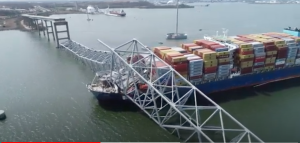About 00:39 on Tuesday morning, the 984-foot-long container ship MV Dali left the Seagirt Marine Terminal in Baltimore, heading down the Patapsco River to the Chesapeake and ultimately to Sri Lanka. It was fully loaded with 4,900 containers, a crew of 21 Indian nationals, and two harbor pilots (one was an apprentice).
Two tugs escorted the Dali out the harbor for about 20 minutes, as was the custom, until they headed back home. Everything was under control. A spring tide was ebbing, and the Dali, powered by a single 55,630-hp, 9-cylinder MAN engine, was cruising at about 8 knots.
About 1:20, something went wrong. The Dali lost propulsion and steering and was heading for the iconic 1.6-mile long Francis Scott Key Bridge, where cars and trucks were traveling on I-695, and eight construction workers were fixing potholes. (Some 30,767 vehicles cross over the bridge every day.)
At 1:25, according to an NTSB timeline, “numerous audible alarms” started sounding. The power stopped, the lights flickered out, and the ship started to swing to starboard, in the direction of one of the bridge piers. At 1:26, the harbor pilot made a VHF call, asking the tugs to return. This was the first sign that the Dali was in distress.
A dispatcher at the pilots’ association heard the call, and immediately called the police on the bridge to warn them of a potential crash.
The pilot ordered the captain to get the engine running and told the crew to steer hard to port. At 1:27 he ordered the crew to drop the port anchor. One of the tugs turned around and started to race back. The emergency generator kicked in, and black smoke billowed from the exhaust stack. The lights, radar and steering were restored, briefly. The pilot made another VHF call, saying the ship had lost power and was approaching the bridge. The Dali hit the bridge at 1:29 at a speed of 7 knots.
A livestream video of the harbor showed the bridge crumple, section by section, and fall into the water. “It was something out of an action movie,” said Baltimore Mayor Brandon Scott. “It was something you never thought you’d see.”
It took the police just 22 seconds after they received the warning call to shut down the bridge; they stopped traffic at both ends. One officer climbed in his car to rescue the eight construction workers. He was too late. The bridge fell just as he started off. Two of the workers were picked up in the water by first responders. More than 50 divers searched all the next day but they could not find the other six, all immigrants from Central America.

The crash shut down the Port of Baltimore, dating to 1670. It now is the largest port handling imported cars in the U.S.; indeed, 847,158 cars and light trucks arrived there in 2023. It handles more than one million tons of cargo a month, and is the nation’s major exporter of farm vehicles and equipment. More than 15,000 people work there.
The Dali was built at the Hyundai yard in South Korea in 2015. It has a 158-foot beam and a 49-foot draft. It displaces 91,128 gross tons. It had arrived in Baltimore on Saturday, coming from New York, unloading some cargo over the weekend. It is owned by a Singapore company, chartered by Maersk, and operated by Synergy Marine.
The Dali had an incident in Antwerp in 2016 when it hit a stone wall there. And last June an inspection in Chile found a deficiency related to “propulsion and auxiliary machinery,” although an inspection by the U.S. Coast Guard in New York three months later found no deficiencies.
The NTSB is leading the investigation of how the Dali hit the bridge. it recovered the Dali‘s black box with the ship’s data and audio recordings. Investigators say that dirty fuel could have caused the engine to shut down. The Wall Street Journal reported that a ship officer said the smell of burning fuel filled the engine room. The NTSB was worried about the 764 tons of HAZMAT materials on board, including some in containers that were damaged.
President Biden said the federal government would provide funding to rebuild the bridge, which opened in 1977 and was named for the composer of the national anthem. The reconstruction, perhaps with a new design, could take years.
